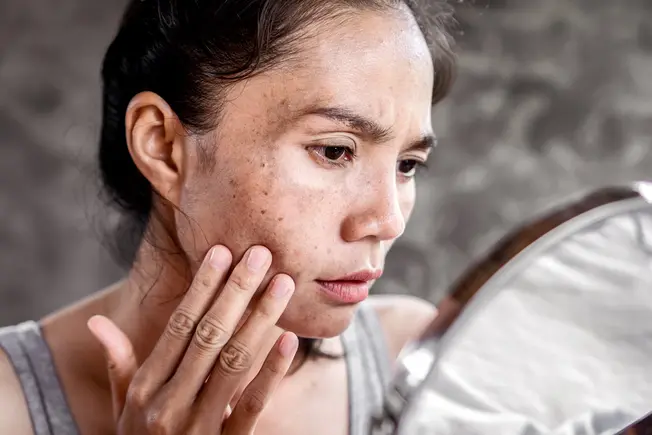How to Fade Age Spots


Treating Age Spots
These small, flat, dark areas on your skin won’t hurt you, so you don’t have to treat them. But if you don’t like how they look, you can make the spots less noticeable or even make them disappear. You also can stop new ones from forming and keep the ones you have from getting darker.

Skin-Lightening Creams and Lotions
You can find lots of skin-lightening products at the drugstore. But before you buy, check the ingredients. Look for creams that contain tranexamic acid, niacinamide, or kojic acid. Keep in mind: For creams to work, you’ll have to use them regularly for weeks or months. And they might irritate your skin.

Beware of Mercury
Make sure nothing on the label suggests your skin lightener contains mercury. It can damage your liver and nerves. People who get close to you while you wear products containing mercury can develop serious health problems, too. You might see the words “mercury” or “mercuric” on the bottle or tube. But products with mercury might also list any of these ingredients: calomel, cinnabaris, hydrargyri oxydum rubrum, or quicksilver.

Get a Prescription
It’s OK to try drugstore products. But a dermatologist could save you time and money on creams that may not work. Your doctor can help figure out which formulas, if any, will be best for your skin. Prescription remedies are stronger than the ones you can buy over the counter. They usually have hydroquinone. Sometimes they have retinoids or a mild steroid, too. You’ll still need to use them regularly for months.

Age Spot Procedures
If you want to get rid of dark spots fast, a procedure that removes layers of discolored skin may work better than a lightening cream. These techniques include laser treatments, freezing (cryotherapy), dermabrasion, microdermabrasion, microneedling, and chemical peels. Keep in mind that procedures cost more than creams. They also come with more risks. Your doctor can help you weigh your options.

Laser Treatment
Your doctor can use narrow beams of light to get rid of the cells that are causing your age spots without damaging the rest of your skin. You’ll probably need more than one treatment for it to work. Lasers might make your skin crust at first or darken your spots. But these side effects usually go away quickly.

Freezing (Cryotherapy)
Your doctor will put liquid nitrogen on your skin for a few seconds. This will freeze the areas where the spots are. As your skin heals, it should get lighter. This treatment can be painful and may cause irritation, swelling, blisters, or redness. There’s a chance it could cause scars or darker patches, too.

Dermabrasion
For this procedure, doctors use a rapidly spinning brush to sand down your spotted skin so new skin can replace it. You may have to do it more than once. The process can cause redness, scabs, and swelling. It could also take a long time for your skin to heal and look normal again.

Microdermabrasion
Microdermabrasion uses tiny crystals to “sand” the skin instead of a spinning brush. It’s easier on your skin than dermabrasion. But you’ll need to have the treatment many times over months to fade your age spots. It might make your skin red or flaky.

Microneedling
In this procedure, the doctor uses fine needles to make tiny, evenly spaced holes in your skin. Your body responds to the little wounds by growing fresh collagen and elastin -- signs of youth -- to heal them. This response can improve the look of age spots and other skin damage.

Chemical Peel
Your doctor will apply an acid-based solution to remove layers of skin where you have age spots. New skin will take its place. You might have to do it more than once to get the results you want. This procedure may cause scarring, infection, or changes in your normal skin color.

Can Foods Help?
You may have seen that certain ingredients in your kitchen like lemon juice, oatmeal, or honey can help with age spots. While these things aren’t going to hurt your skin, they probably won’t do much for your age spots. If you really want those spots to fade, it’s best to use products or procedures that your doctor recommends.

Try Some Makeup
No matter which treatment you choose, getting rid of those age spots will take time. In the meantime, you could try using makeup to cover them up and make them harder to see.

Age Spot Prevention
To keep age spots lighter and avoid new ones, try these tips. Avoid the sun, especially at times when it’s most intense. Use a good, broad-spectrum sunscreen before you go outside, and reapply often. Wear gloves, a hat, or other clothing to protect the areas where you have age spots.

Consider Your Skin Type
Age spots are more likely if you have fair skin. But people with any skin color or type can get them. A doctor can help you decide the best way to fade age spots, given your skin color and type or other things.
IMAGES PROVIDED BY:
- Getty
- Getty
- Getty
- Getty
- Getty
- Getty
- Getty
- Getty
- Getty
- Getty
- Getty
- Getty
- Getty
- Getty
- Getty
SOURCES:
Mayo Clinic: “Age spots (liver spots).”
Cleveland Clinic: “How to Get Rid of Age Spots (or Liver Spots) and Avoid More.”
American Academy of Dermatology Association: “What can get rid of age spots?” “Skin lightener containing mercury can cause serious health problems,” “How to fade dark spots in skin of color.”
